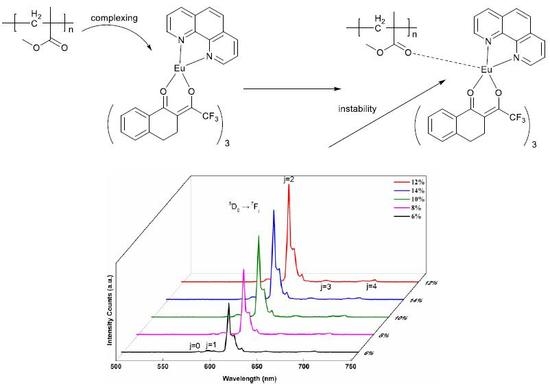The Coordination and Luminescence of the Eu(III) Complexes with the Polymers (PMMA, PVP)
Abstract
:1. Introduction
2. Synthesis and Characterization
2.1. Synthesis of 2-(2,2,2-trifluoroethyl)-1-tetralone (TFT) and 2-(2,2,3,3,3-pentafluoropropanoyl)-3,4-dihydronaphthalen-1(2H)-one (PFP)
2.2. Syntheses of Complexes 1–6
2.3. Molecular Structures of the Complexes 1 and 2
2.4. Morphology of Composite Nanofibers and Dispersion of Eu/PMMA.
3. Results and Discussion
3.1. UV–Vis Spectral Analysis
3.2. Thermal Stability Analysis
3.3. The Photoluminescent Properties of Complexes
3.4. The Photoluminescent Properties of PMMA, PVP/Complexes Composites
3.5. Fluorescence Lifetimes and Fluorescence Quantum Efficiencies of Complexes 1–6 and Eu(TFT)3bpy/PMMA, Eu(TFT)3phen/PMMA
4. Conclusions
Supplementary Materials
Author Contributions
Acknowledgments
Conflicts of Interest
Appendix A
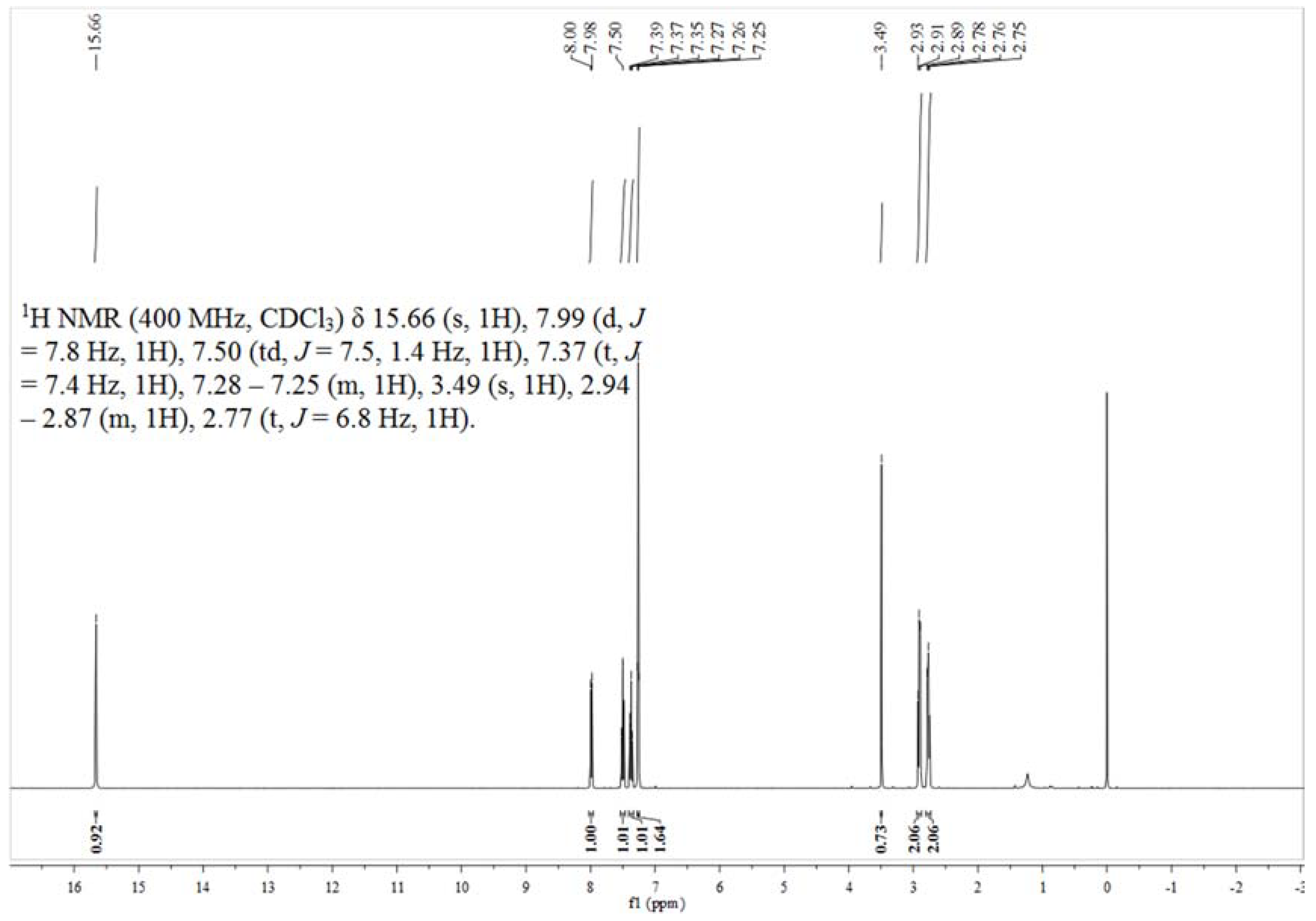
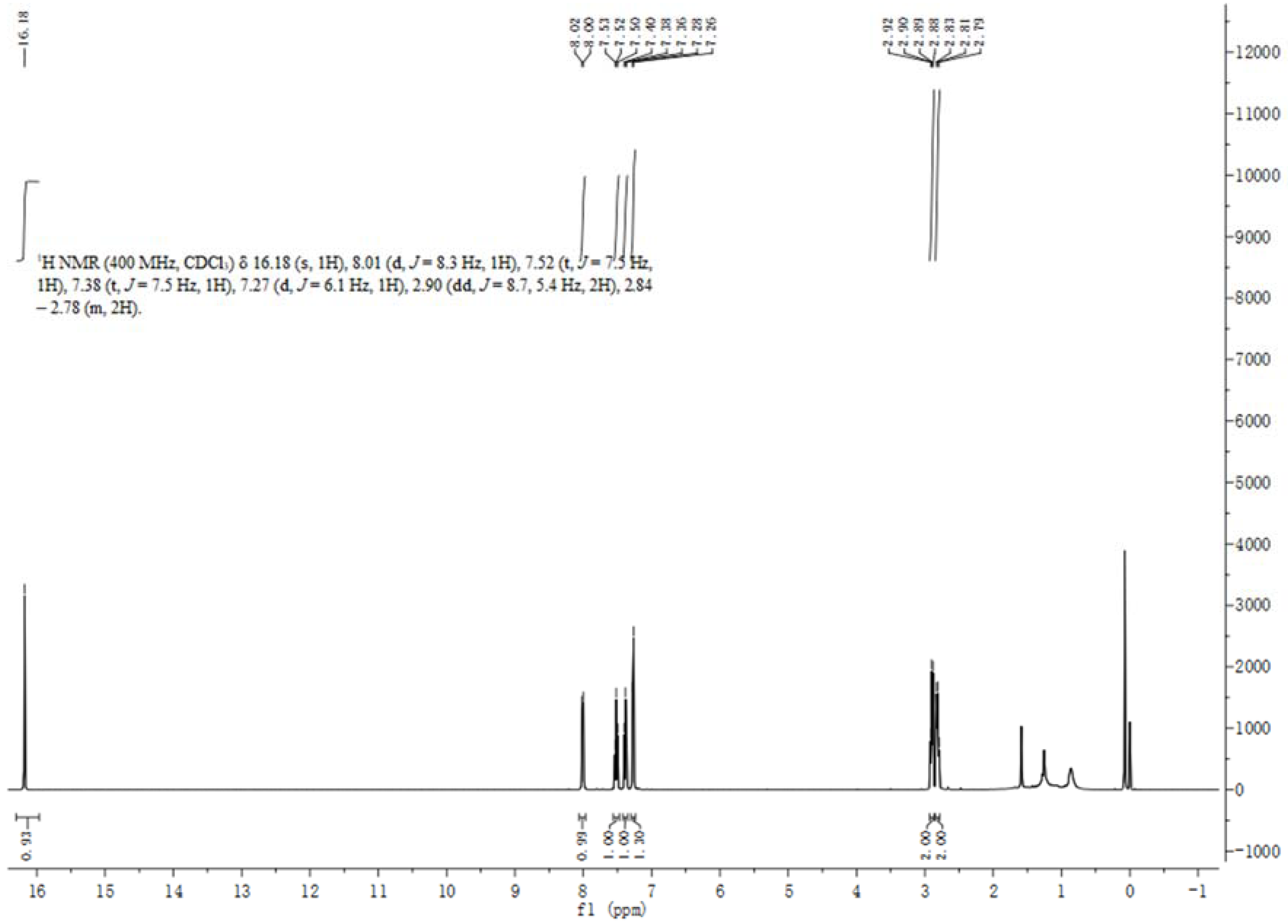
Appendix B


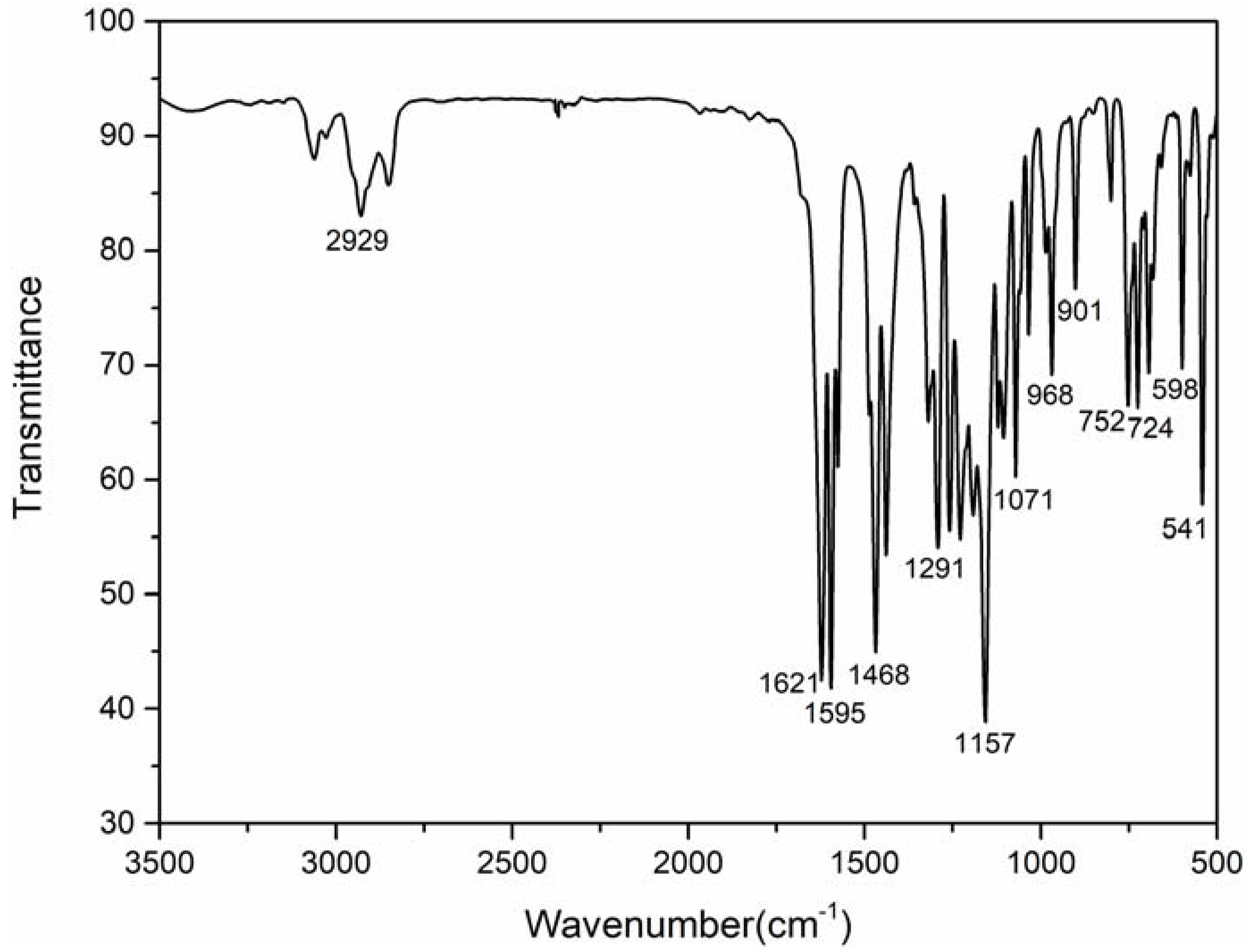


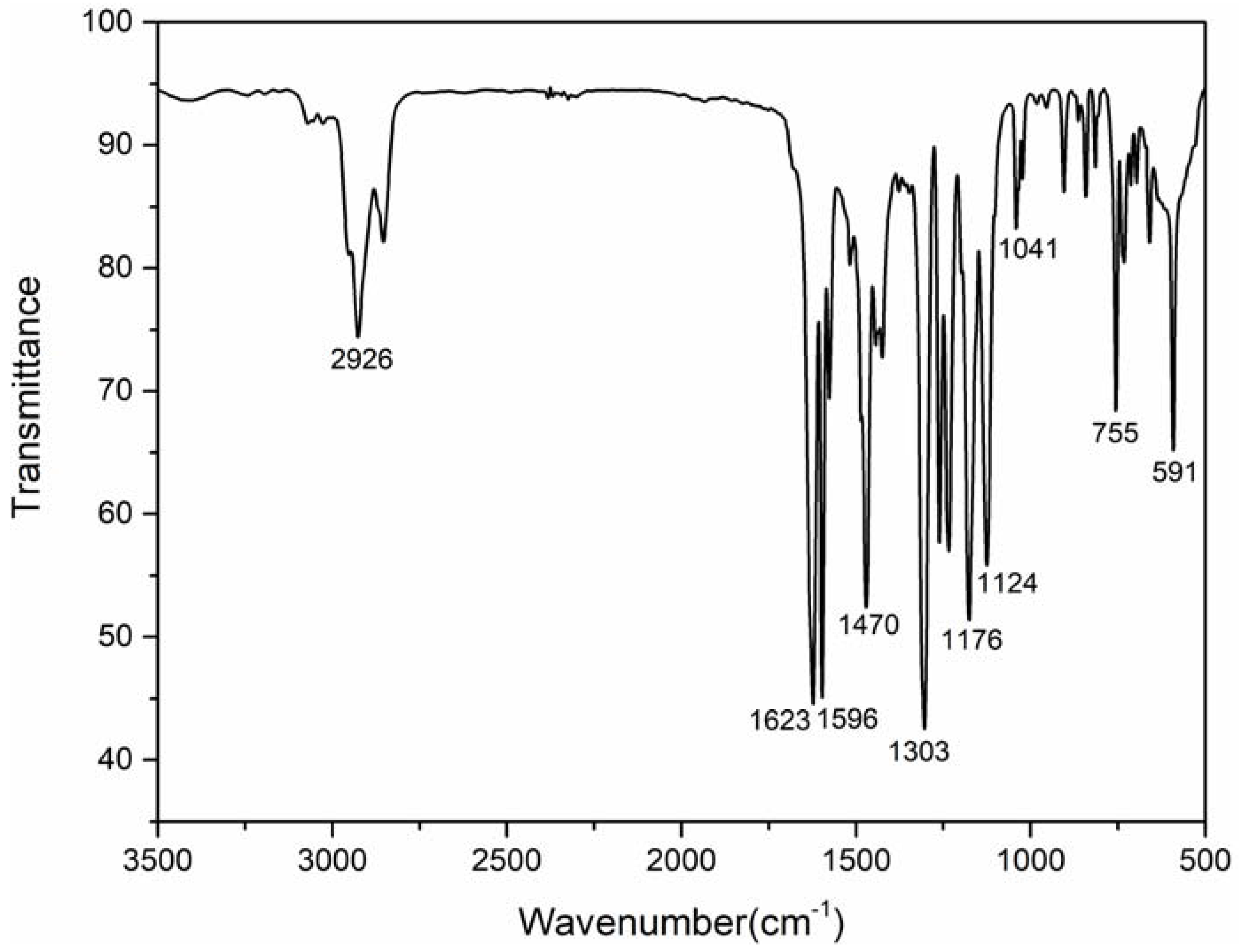
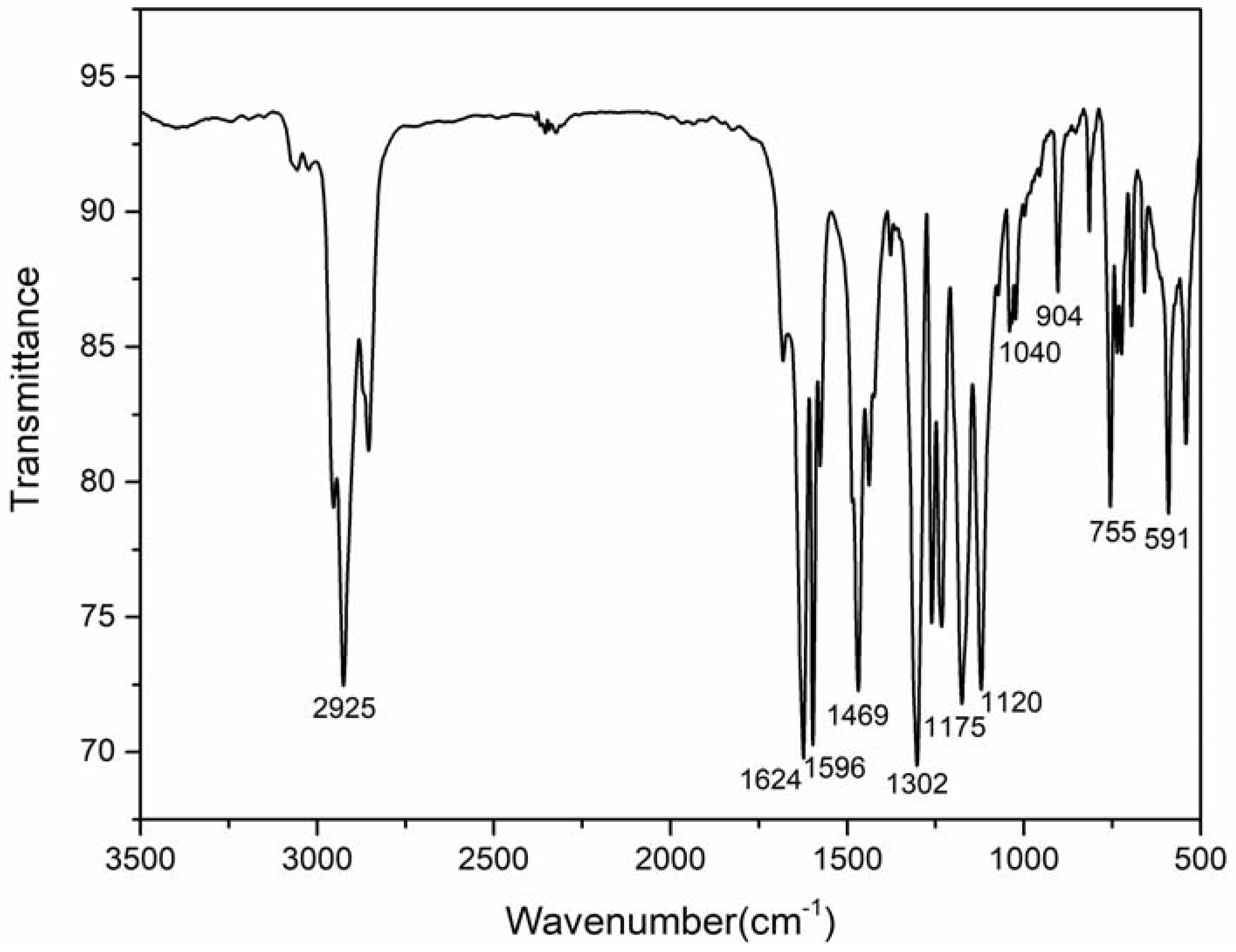
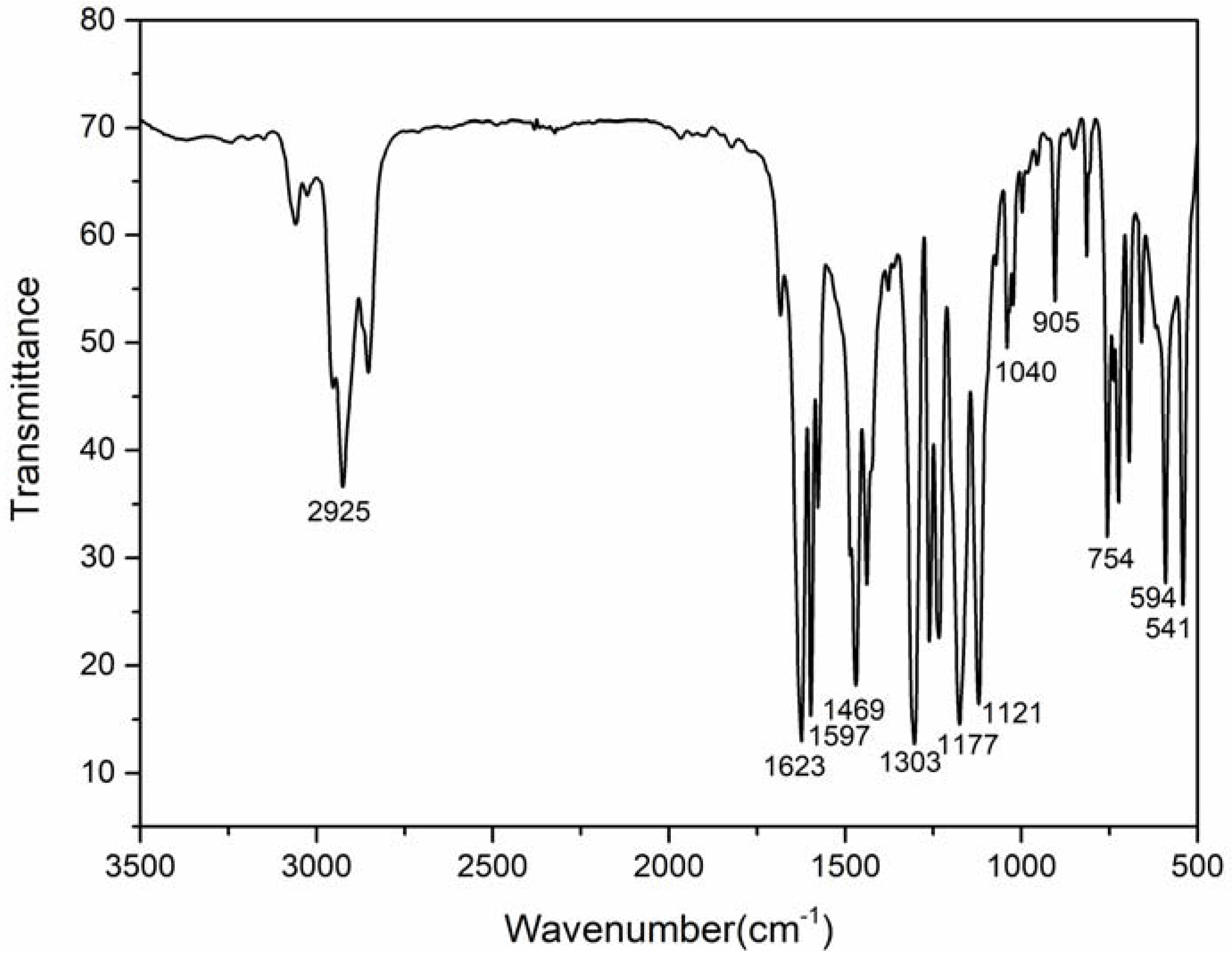

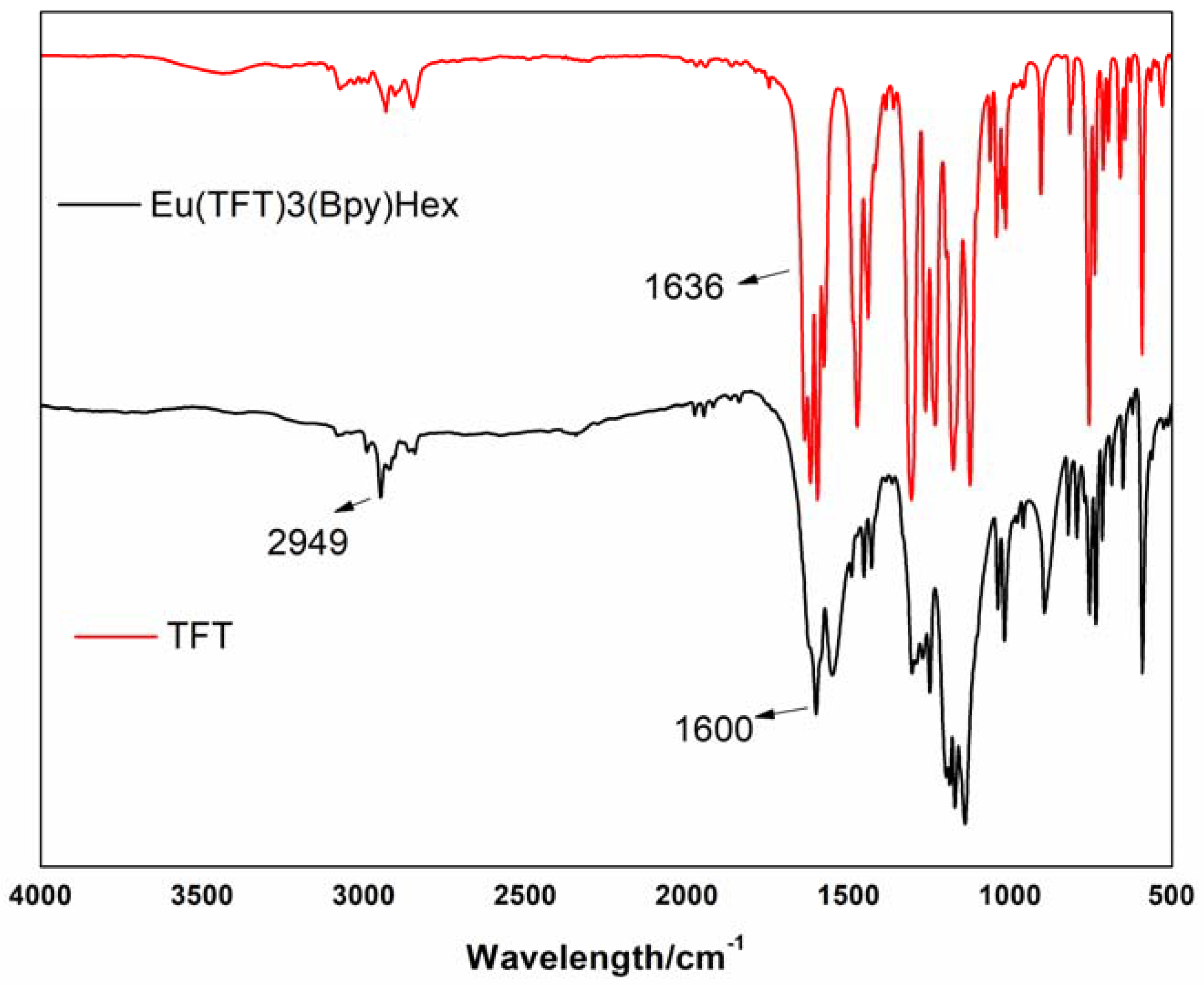
Appendix C

Appendix D
| Bond Lengths | |
|---|---|
| Eu(1)-O1 | 2.347(4) |
| Eu(1)-O2 | 2.351(5) |
| Eu(1)-O3 | 2.324(4) |
| Eu(1)-O4 | 2.347(4) |
| Eu(1)-O5 | 2.354(4) |
| Eu(1)-O6 | 2.358(4) |
| Eu(1)-N1 | 2.590(5) |
| Eu(1)-N2 | 2.586(5) |
| Bond Lengths | |||
|---|---|---|---|
| Eu(1)-O1 | 2.341(3) | C(3S)-C(2S) | 1.41(3) |
| Eu(1)-O2 | 2.368(3) | C(3S)-C(3S)#1 | 1.46(4) |
| Eu(1)-O3 | 2.356(3) | C(1S)-C(2S) | 1.542(9) |
| Eu(1)-O4 | 2.347(3) | ||
| Eu(1)-O5 | 2.351(3) | ||
| Eu(1)-O6 | 2.379(3) | ||
| Eu(1)-N1 | 2.576(3) | ||
| Eu(1)-N2 | 2.590(8) | ||
| Sn | Confign | CI codff | E/nm (eV) | Oscillator | Assignt |
|---|---|---|---|---|---|
| S1 | H → L + 2 | 0.2898 | 277.23(4.47) | 0.1533 | ILCT/LMCT/MLCT/MC |
| S2 | H → L + 3 | 0.3316 | 275.69(4.49) | 0.3093 | ILCT |
| S3 | H-1 → L + 2 | 0.1572 | 266.16(4.66) | 0.4822 | ILCT/LMCT/MLCT/MC |
| S4 | H → L + 1 | 0.1091 | 254.70(4.87) | 0.0279 | LMCT/MLCT/MC |
| S5 | H → L | 0.1363 | 249.71(4.97) | 0.0024 | LMCT/MLCT/MC |
| Samples | τ (ms) | Фoverall (%) |
|---|---|---|
| Eu(TFT)3phen | 314 | 52.17 |
| Eu(TFT)3bpy | 172 | 48.93 |
| Eu(TFT)3phen/PMMA | 28 | 19.17 |
| Eu(TFT)3bpy/PMMA | 26 | 18.81 |
| Eu(TFT)3(TPPO) | 45.2 | 20.76 |
| Eu(TFT)3(TPPO)2 | 62.4 | 21.97 |
| Eu(PFP)3(TPPO) | 62 | 21.91 |
| Eu(PFP)3(TPPO)2 | 70 | 22.17 |
References
- Carlos, L.D.; Ferreira, R.A.; Bermudez, V.Z.; Ribeiro, S.J. Lanthanide-containing light-emitting organic-inorganic hybrids: A bet on the future. Adv. Mater. 2009, 40, 509–534. [Google Scholar] [CrossRef] [PubMed]
- Shelton, A.H.; Sazanovich, I.V.; Weinstein, J.A.; Ward, M.D. Controllable three-component luminescence from a 1,8-naphthalimide/Eu(III) complex: White light emission from a single molecule. Chem. Commun. 2012, 48, 2749–2751. [Google Scholar] [CrossRef] [PubMed]
- Bruno, S.M.; Ferreira, R.A.S.; Carlos, L.D.; Pillinger, M.; Ribeiro-Claro, P.; Goncalves, I.S. Synthesis, characterisation and luminescence properties of MCM-41 impregnated with an Eu3+, β-diketonate complex. Microporous Mesoporous Mater. 2008, 113, 453–462. [Google Scholar] [CrossRef]
- Wang, D.; Luo, Z.; Liu, Z.; Wang, D.; Fan, L.; Yin, G. Synthesis and photoluminescent properties of Eu (III) complexes with fluorinated β-diketone and nitrogen heterocyclic ligands. Dyes Pigment. 2016, 132, 398–404. [Google Scholar] [CrossRef]
- Hamblin, J.; Abboyi, N.; Lowe, M.P. A binaphthyl-containing Eu complex and its interaction with human serum albumin: A luminescence study. Chem. Commun. 2005, 5, 657–659. [Google Scholar] [CrossRef] [PubMed]
- Lv, Y.; Zhang, J.; Cao, W.; Fu, Y.; han, Z. Luminescence properties of complex Tb0.25Eu0.75(TTA)2(N-HPA)Phen. J. Alloy. Compd. 2009, 468, 406–409. [Google Scholar] [CrossRef]
- Lapaev, D.V.; Nikiforov, V.G.; Safiullin, G.M.; Lobkov, V.S.; Knyazev, A.A.; Krupin, A.S.; Galyametdinov, Y.G. Changes in luminescent properties of vitrified films of terbium(III) β-diketonate complex upon UV laser irradiation. J. Lumin. 2016, 175, 106–112. [Google Scholar] [CrossRef]
- Wang, L.; Wang, W.; Zhang, W.; Kang, E.; Huang, W. Synthesis and Luminescence Properties of Novel Eu-Containing copolymers Consisting of Eu(III)-Acrylate-β-Diketonate Complex Monomers and Methyl Methacrylate. Chem. Mater. 2000, 12, 2212–2218. [Google Scholar] [CrossRef]
- Yang, C.; Liu, S.; Xu, J.; Li, Y.; Shang, M.; Lei, L.; Wang, G.; He, J.; Wang, X.; Lu, M. Efficient red emission from poly(vinyl butyral) films doped with a novel europium complex based terpyridyl as ancillary ligand: Synthesis, structural elucidation by Sparkle/RM1 calculation, and photophysical properties. Polym. Chem. 2016, 7, 1147–1157. [Google Scholar] [CrossRef]
- Yang, C.; Xu, J.; Zhang, Y.; Li, Y.; Zheng, J.; Lianga, L.; Lu, M. Efficient monochromatic red-light-emitting PLEDs based on a series of nonconjugated Eu-polymers containing a neutral terpyridyl ligand. J. Mater. Chem. C 2013, 1, 4885–4901. [Google Scholar] [CrossRef]
- Yang, C.; Xu, J.; Ma, J.; Zhu, D.; Zhang, Y.; Lianga, L.; Lu, M. An efficient long fluorescence lifetime polymer-based sensor based on europium complex as chromophore for the specific detection of F−, CH3COO−, and H2PO4−. Polym. Chem. 2012, 3, 2640–2648. [Google Scholar] [CrossRef]
- Cai, J.; Niu, H.; Wang, C.; Ma, L.; Bai, X.; Wang, W. Tuning the bandgaps of polyazomethines containing triphenylamine by different linkage sites of dialdhyde monomers. Electrochim. Acta 2012, 76, 229–241. [Google Scholar] [CrossRef]
- And, J.S.Y.; Swager, T.M. Fluorescent Porous Polymer Films as TNT Chemosensors: Electronic and Structural Effects. J. Am. Chem. Soc. 2017, 120, 11864–11873. [Google Scholar]
- Li, W.; Tao, Y.; An, G.; Yan, P.; Li, Y.; Li, G. One-dimensional luminescent composite nanofibers of Eu(TFI)3TPPO/PVP prepared by electrospinning. Dyes Pigment. 2017, 146, 47–53. [Google Scholar] [CrossRef]
- Zhang, X.; Wen, S.; Hu, S.; Chen, Q.; Fong, H.; Zhang, L.; Liu, L. Luminescence Properties of Eu(III) Complex/Polyvinylpyrrolidone Electrospun Composite Nanofibers. J. Phys. Chem. C 2013, 114, 3898–3903. [Google Scholar] [CrossRef]
- Miller, R.D.; Hofer, D.; Rabolt, J.; Fickes, G.N. Anomalously long-wavelength electronic transition in conformationally locked organosilane high polymers. J. Am. Chem. Soc. 2002, 107, 2172–2174. [Google Scholar] [CrossRef]
- Jiang, B.; Yang, S.W.; Bailey, S.L.; Hermans, L.G.; Niver, R.A.; Bolcar, M.A.; Jones, W.E., Jr. Toward transparent molecular wires: Electron and energy transfer in transition metal derivatized conducting polymers. Coord. Chem. Rev. 1998, 171, 365–386. [Google Scholar] [CrossRef]
- Taydakov, I.V.; Akkuzina, A.A.; Avetisov, R.I.; Khomyakov, A.V.; Saifutyarov, R.R.; Avetissov, I.C. Effective electroluminescent materials for OLED applications based on lanthanide 1,3-diketonates bearing pyrazole moiety. J. Lumin. 2016, 177, 31–39. [Google Scholar] [CrossRef]
- Zhai, L.; Zhang, F.; Sun, J.; Liu, M.; Sun, M.; Lu, R. New non-traditional oranogelator of β-diketone-boron difluoride complexes with terminal tetraphenylethene: Self-assembling and fluorescent sensory properties towards amines. Dyes Pigment. 2017, 145, 54–62. [Google Scholar] [CrossRef]
- Zhang, X.; Lu, R.; Jia, J.; Liu, X.; Xue, P.; Xu, D.; Zhou, H. Organogel based on β-diketone-boron difluoride without alkyl chain and H-bonding unit directed by optimally balanced π-π interaction. Chem. Commun. 2010, 46, 8419–8421. [Google Scholar] [CrossRef] [PubMed]
- Pereira, C.C.; Dias, S.; Coutinho, I.; Leal, J.P.; Branco, L.C.; Laia, C.A. Europium(III) tetrakis(beta-diketonate) complex as an ionic liquid: A calorimetric and spectroscopic study. Inorg. Chem. 2013, 52, 3755–3764. [Google Scholar] [CrossRef] [PubMed]
- Melby, L.R.; Rose, N.J.; Abramson, E.; Caris, J.C. Synthesis and Fluorescence of Some Trivalent Lanthanide Complexes. J. Am. Chem. Soc. 1964, 86, 5117–5125. [Google Scholar] [CrossRef]
- Armelao, L.; Quici, S.; Barigelletti, F.; Accorsi, G.; Bottaro, G.; Cavazzini, M.; Tondello, E. Design of luminescent lanthanide complexes: From molecules to highly efficient photo-emitting materials. Coord. Chem. Rev. 2010, 254, 487–505. [Google Scholar] [CrossRef]
- Han, Y.; Yan, P.; Sun, J.; An, G.; Yao, X.; Li, Y.; Li, G. Luminescence and white-light emitting luminescent sensor of tetrafluoroterephthalate-lanthanide metal-organic frameworks. Dalton Trans. 2017, 46, 4642–4653. [Google Scholar] [CrossRef] [PubMed]
- Wang, D.; Pi, Y.; Liu, H.; Wei, X.; Hu, Y.; Zheng, J. Synthesis and spectroscopic behavior of highly luminescent trinuclear europium complexes with tris-β-diketone ligand. J. Alloy. Compd. 2014, 613, 13–17. [Google Scholar] [CrossRef]
- Congiu, M.; Alamiry, M.; Moudam, O.; Ciorba, S.; Richardson, P.R.; Maron, L.; Jones, A.C.; Richards, B.S.; Robertson, N. Preparation and photophysical studies of [Ln(hfac)3DPEPO], Ln = Eu, Tb, Yb, Nd, Gd; interpretation of total photoluminescence quantum yields. Dalton Trans. 2013, 42, 13537–13545. [Google Scholar] [CrossRef] [PubMed]
- Divya, V.; Sankar, V.; Raghu, K.G.; Reddy, M.L. A mitochondria-specific visible-light sensitized europium beta-diketonate complex with red emission. Dalton Trans. 2013, 42, 12317–12323. [Google Scholar] [CrossRef] [PubMed]
- Xu, H.; Hu, H.C.; Cao, C.S.; Zhao, B. Lanthanide organic framework as a regenerable luminescent probe for Fe3+. Inorg. Chem. 2015, 54, 4585–4587. [Google Scholar] [CrossRef] [PubMed]
- Ma, X.; Li, X.; Yue, C.; Jin, L.P. Highly Thermostable One-Dimensional Lanthanide(III) Coordination Polymers Constructed from Benzimidazole-5,6-dicarboxylic Acid and 1,10-Phenanthroline: Synthesis, Structure, and Tunable White-Light Emission. Cryst. Growth Des. 2012, 12, 5227–5232. [Google Scholar] [CrossRef]
- Freund, C.; Porzio, W.; Giovanella, U.; Vignali, F.; Pasini, M.; Destri, S. Thiophene based europium β-diketonate complexes: Effect of the ligand structure on the emission quantum yield. Inorg. Chem. 2011, 50, 5417–5429. [Google Scholar] [CrossRef] [PubMed]
- Singh, A.K.; Singh, S.K.; Mishra, H.; Prakash, R.; Rai, S.B. Structural, Thermal, and Fluorescence Properties of Eu (DBM)3Phenx Complex Doped in PMMA. J. Phys. Chem. B 2010, 114, 13042–13051. [Google Scholar] [CrossRef] [PubMed]
- Biju, S.; Freire, R.O.; Eom, Y.K.; Scopelliti, R.; Bünzli, J.C.; Kim, H.K. A EuIII tetrakis (β-diketonate) dimeric complex: Photophysical properties, structural elucidation by sparkle/AM1 calculations, and doping into PMMA films and nanowires. Inorg. Chem. 2014, 53, 8407–8417. [Google Scholar] [CrossRef] [PubMed]
- Aromí, G.; Gamez, P.; Reedijk, J. Poly beta-diketones: Prime ligands to generate supramolecular metalloclusters. Coord. Chem. Rev. 2008, 252, 964–989. [Google Scholar]
- Hou, Z.; Li, G.; Lian, H.; Lin, J. One-dimensional luminescent materials derived from the electrospinning process: Preparation, characteristics and application. J. Mater Chem. 2012, 22, 5254–5276. [Google Scholar] [CrossRef]
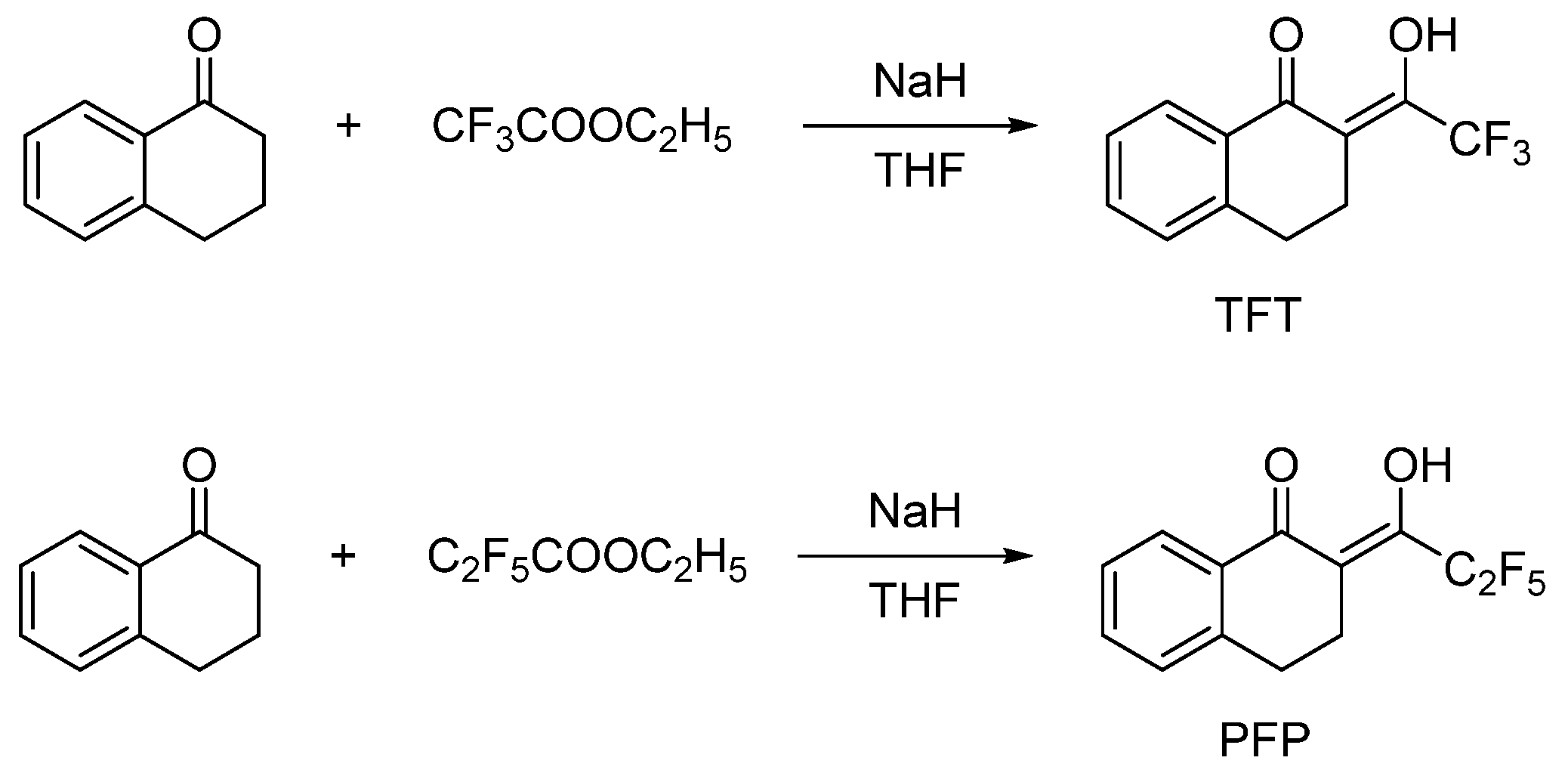
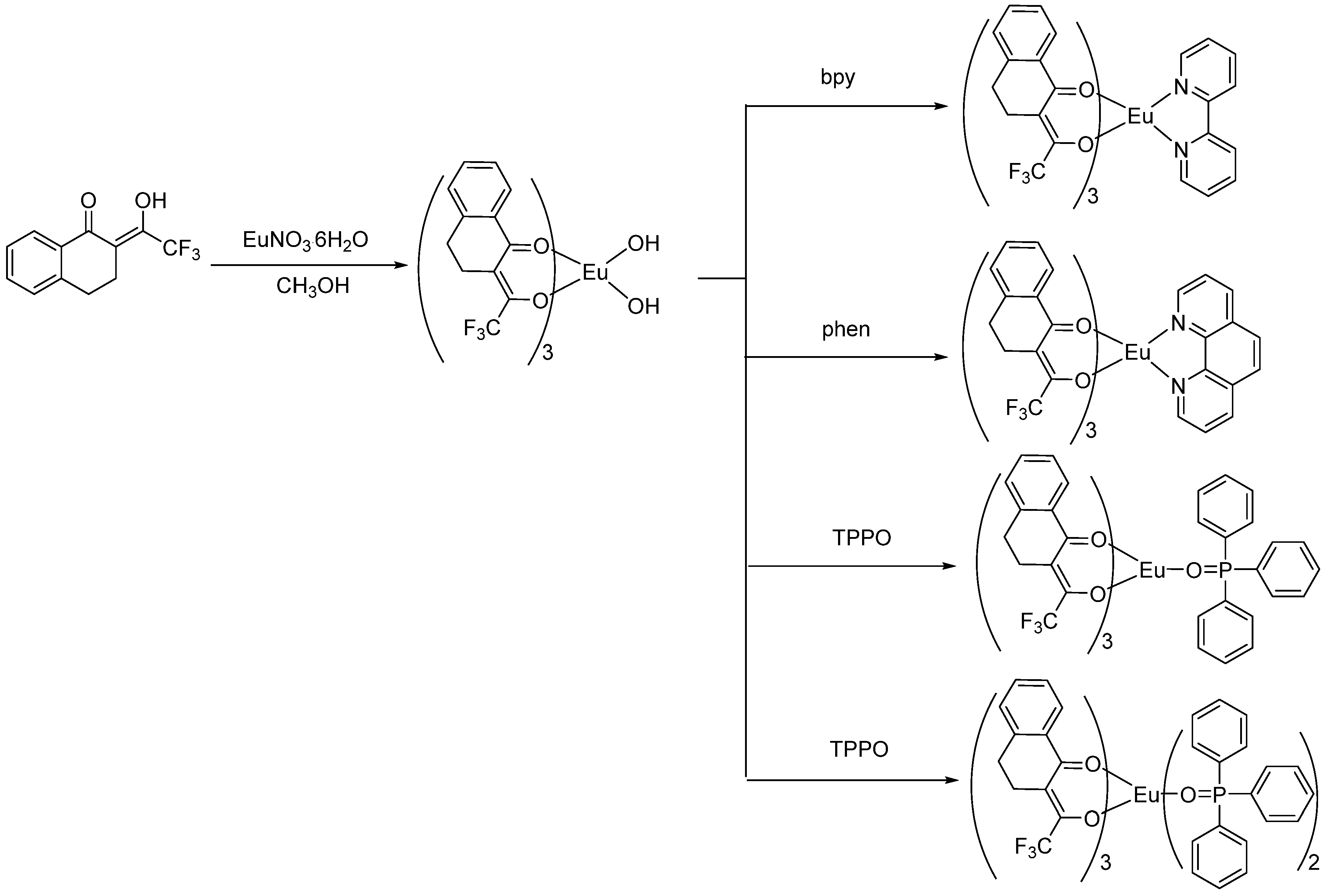

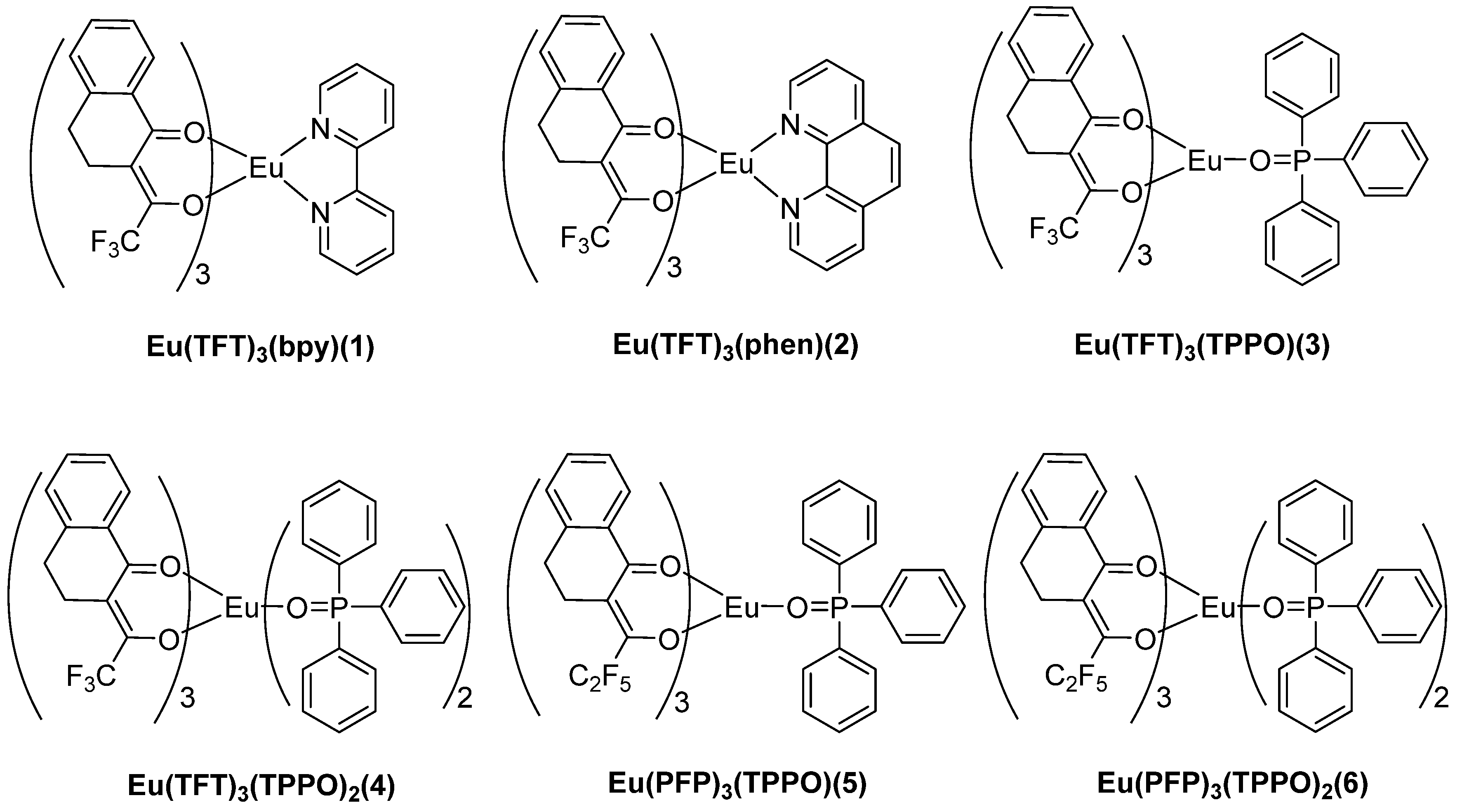
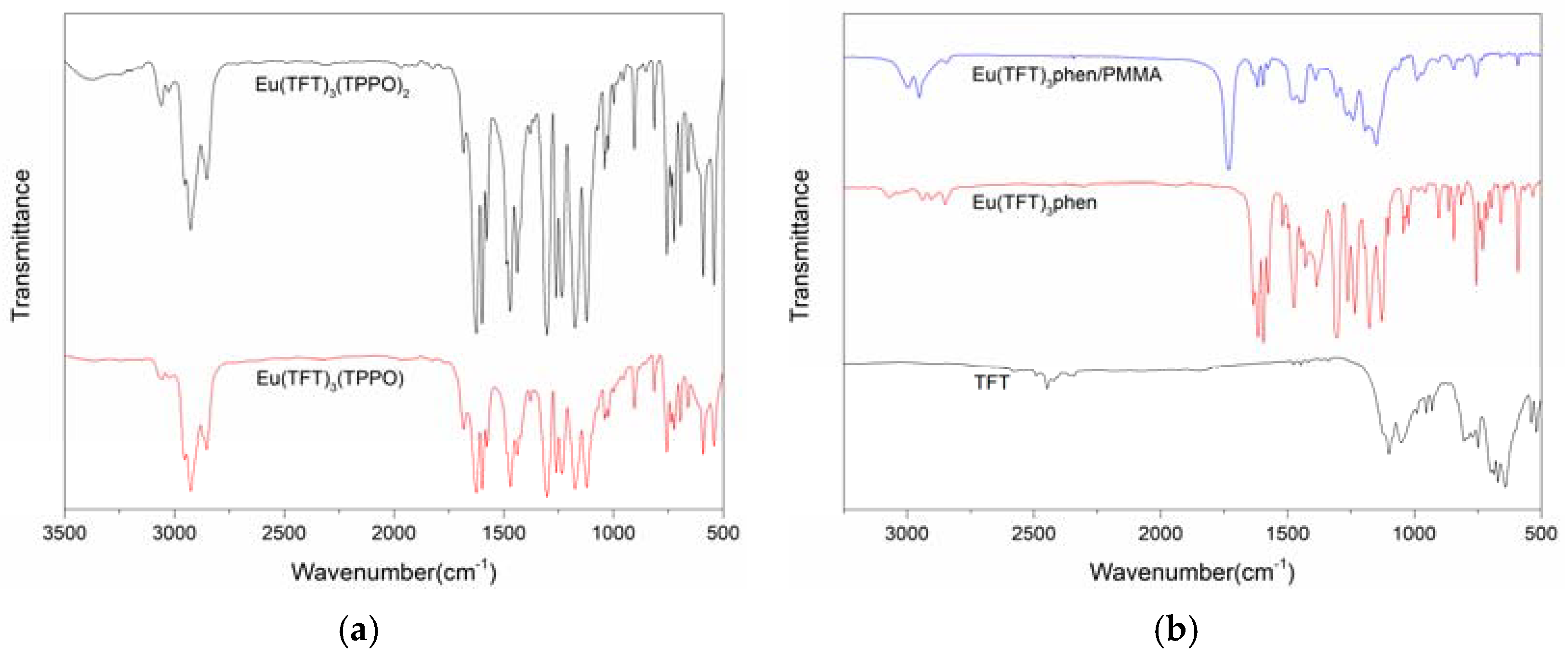


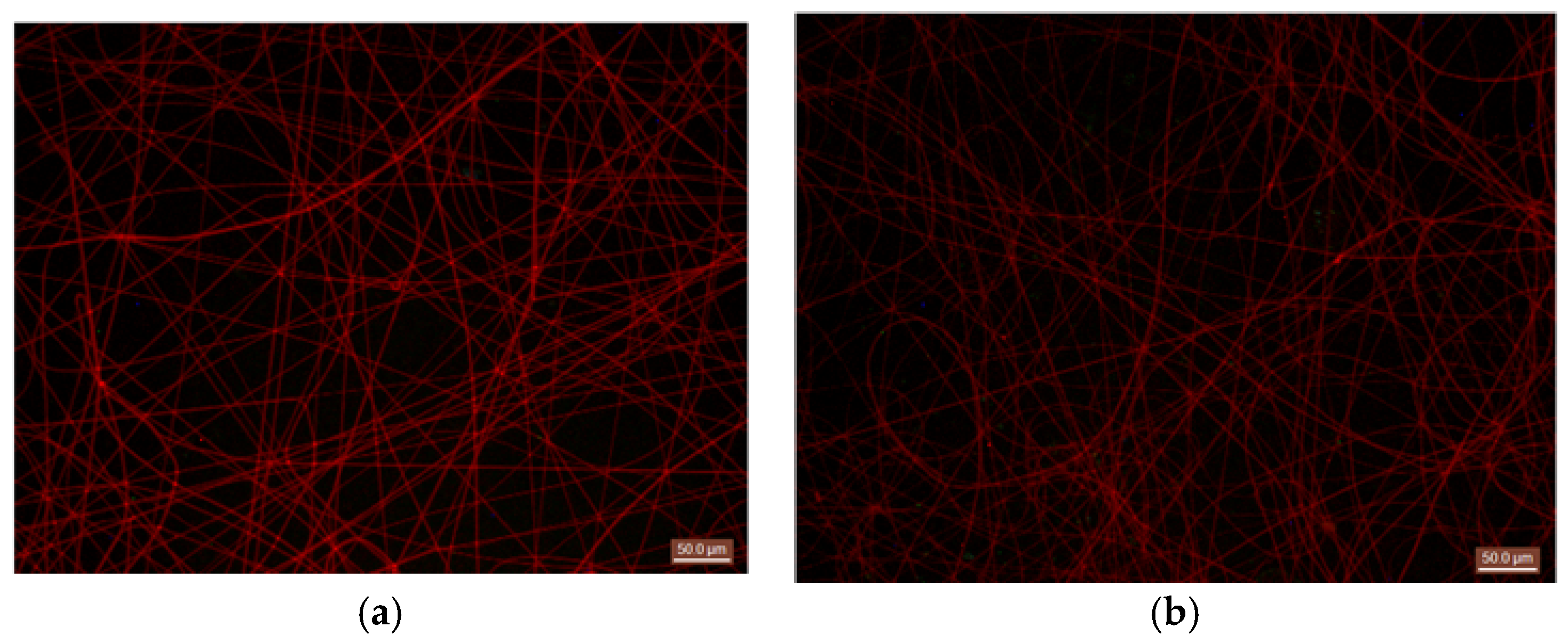
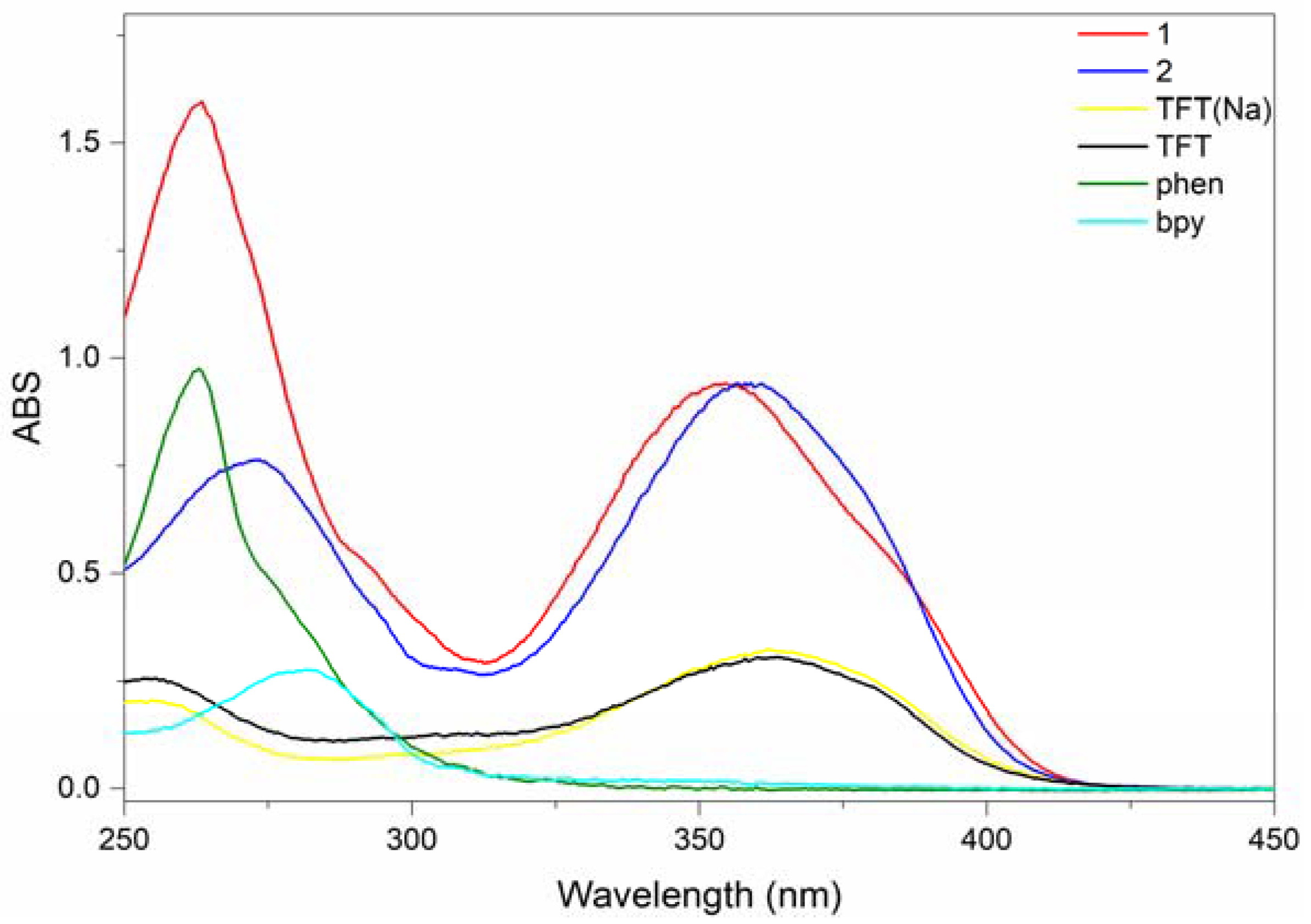
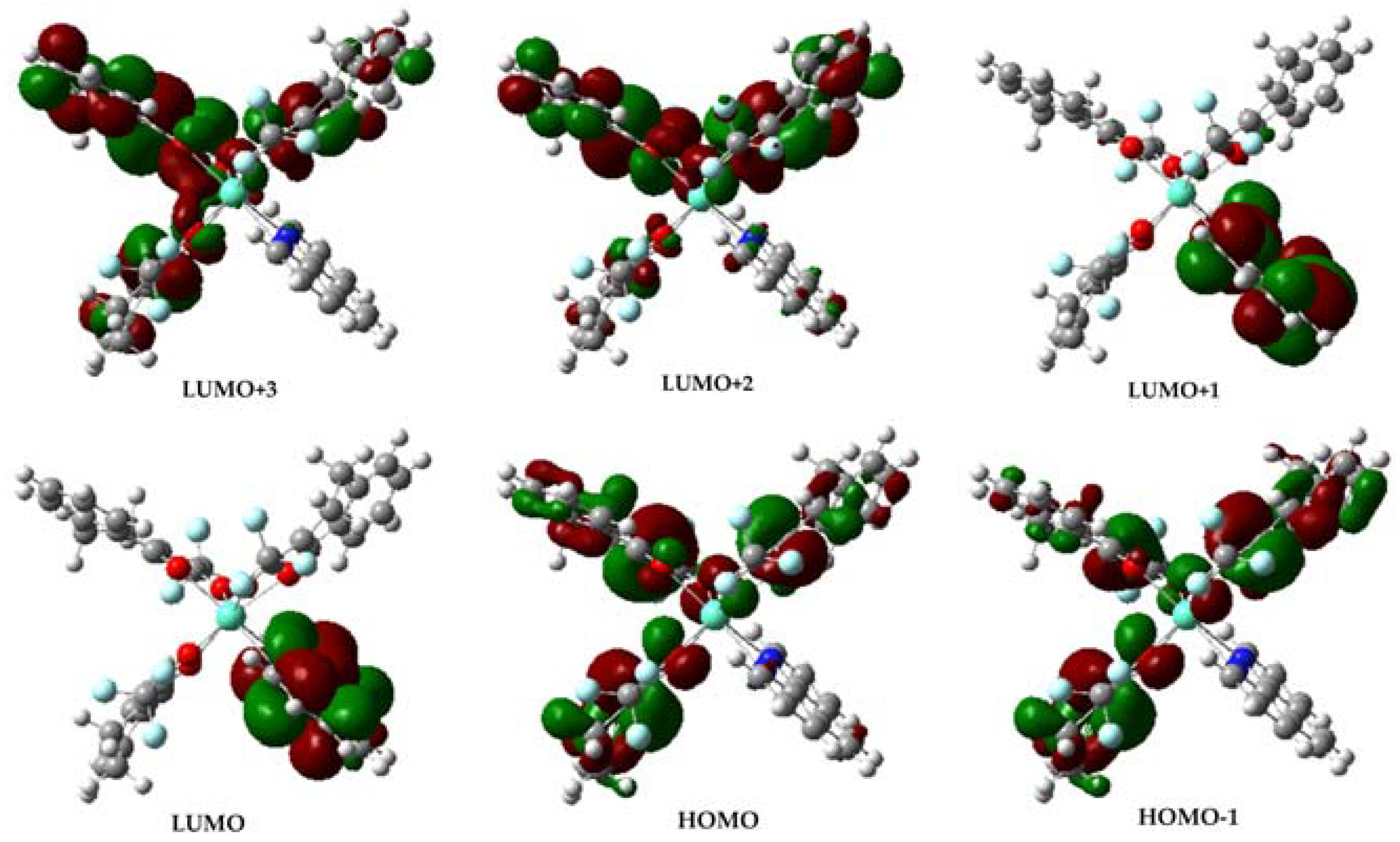


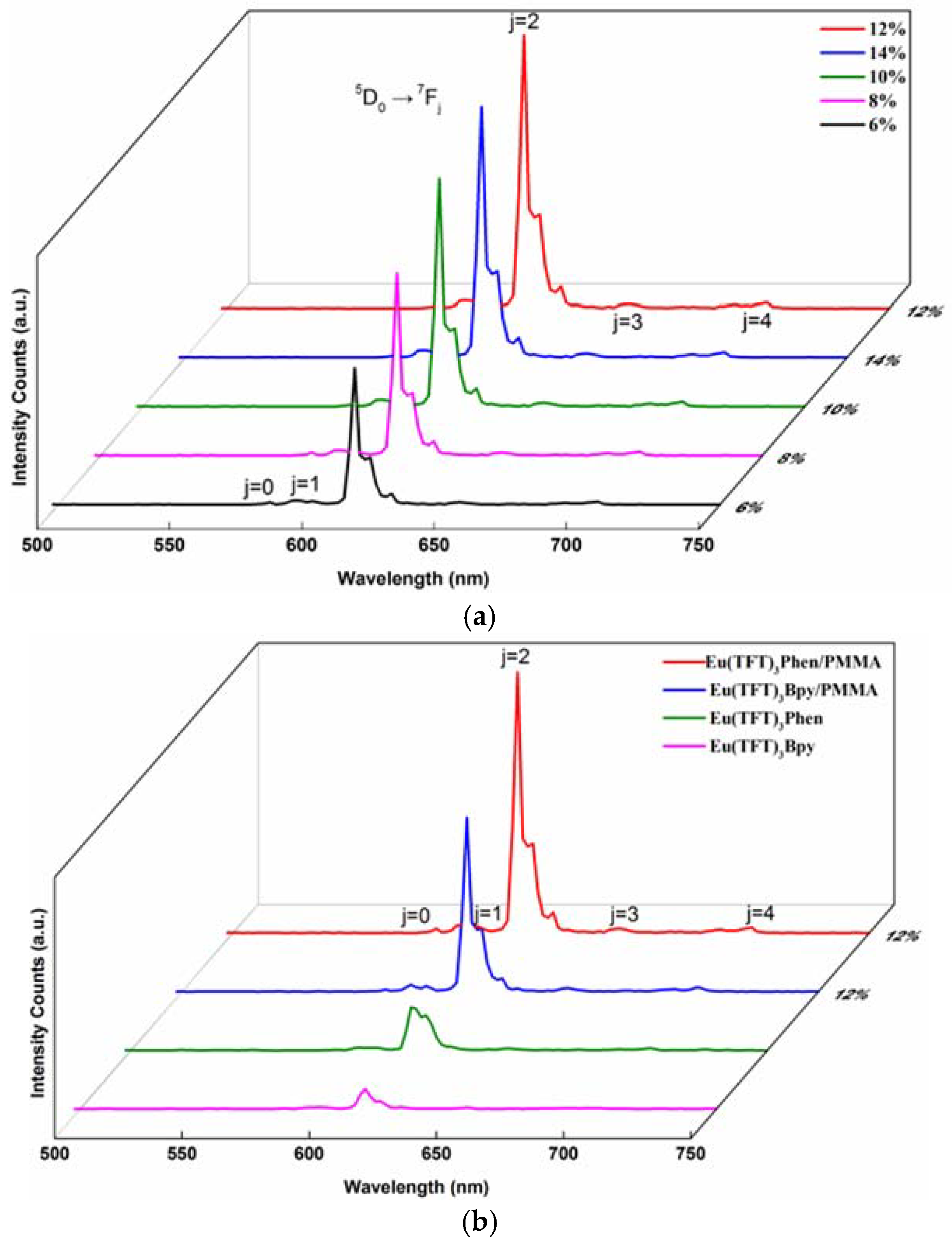

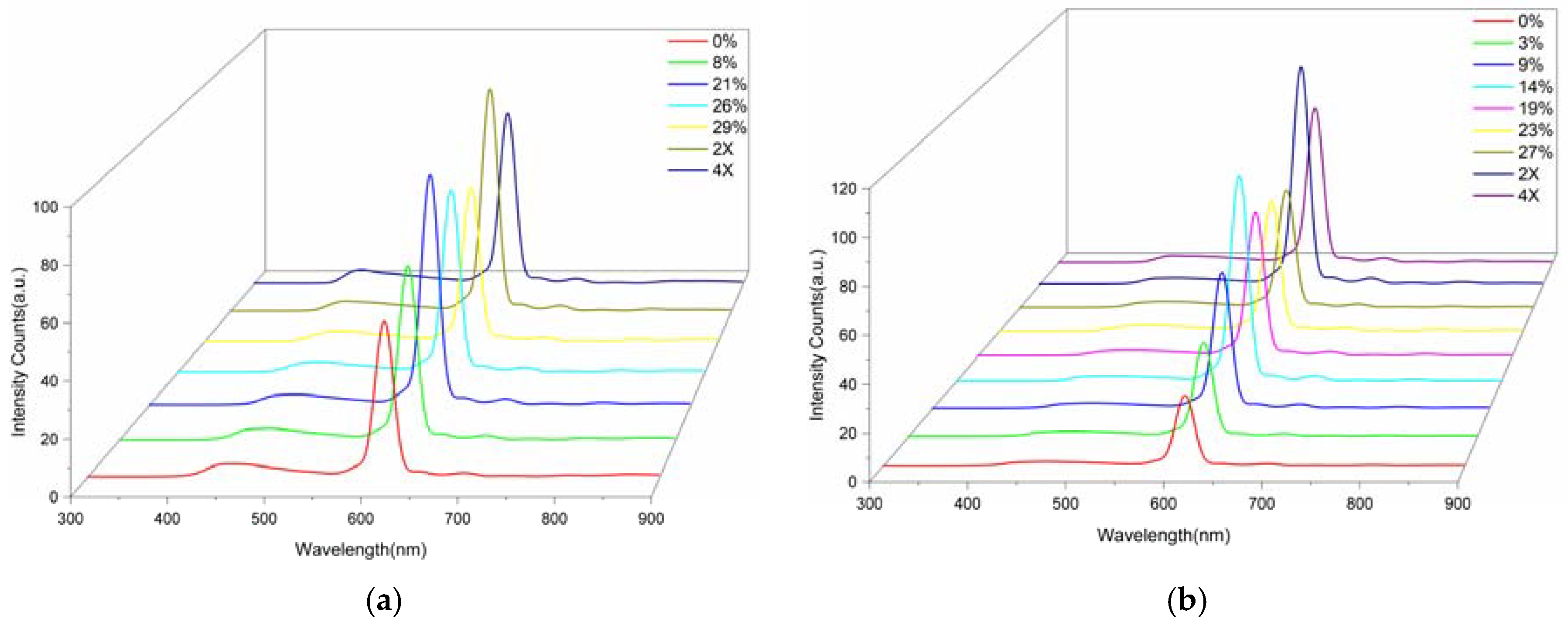
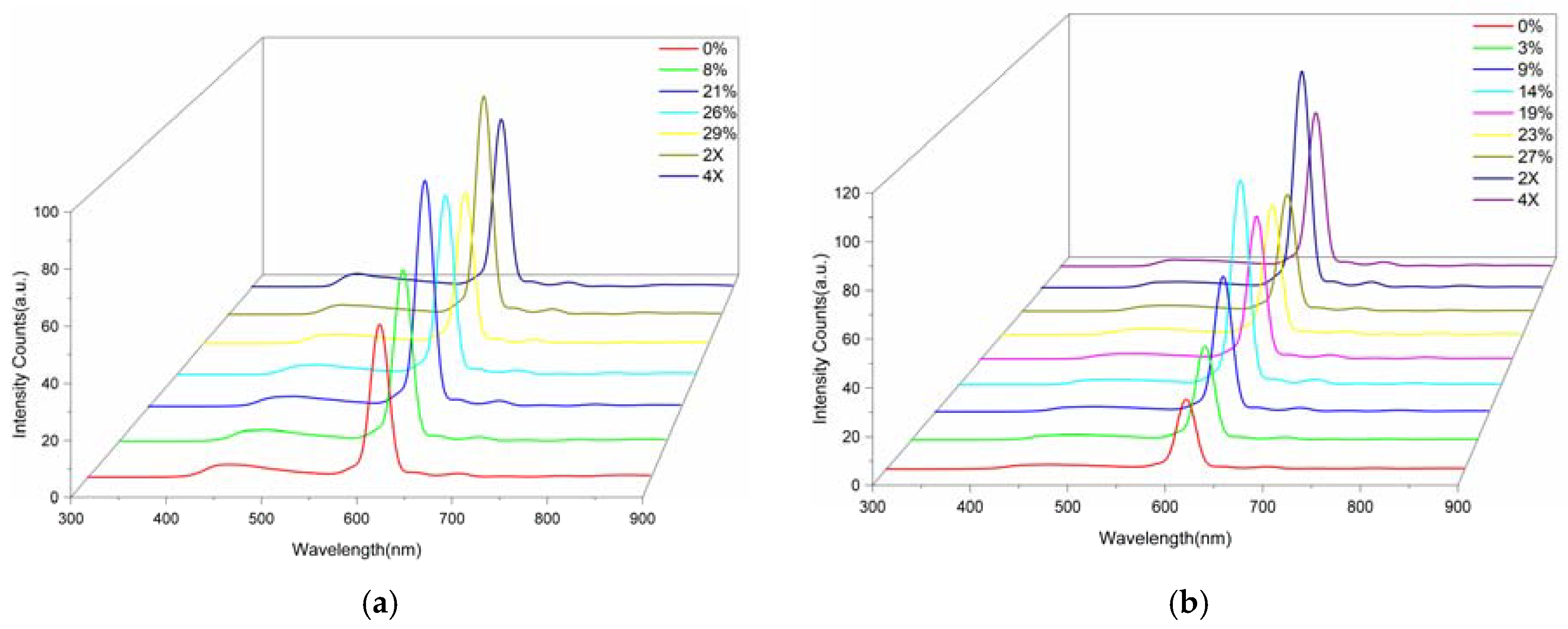
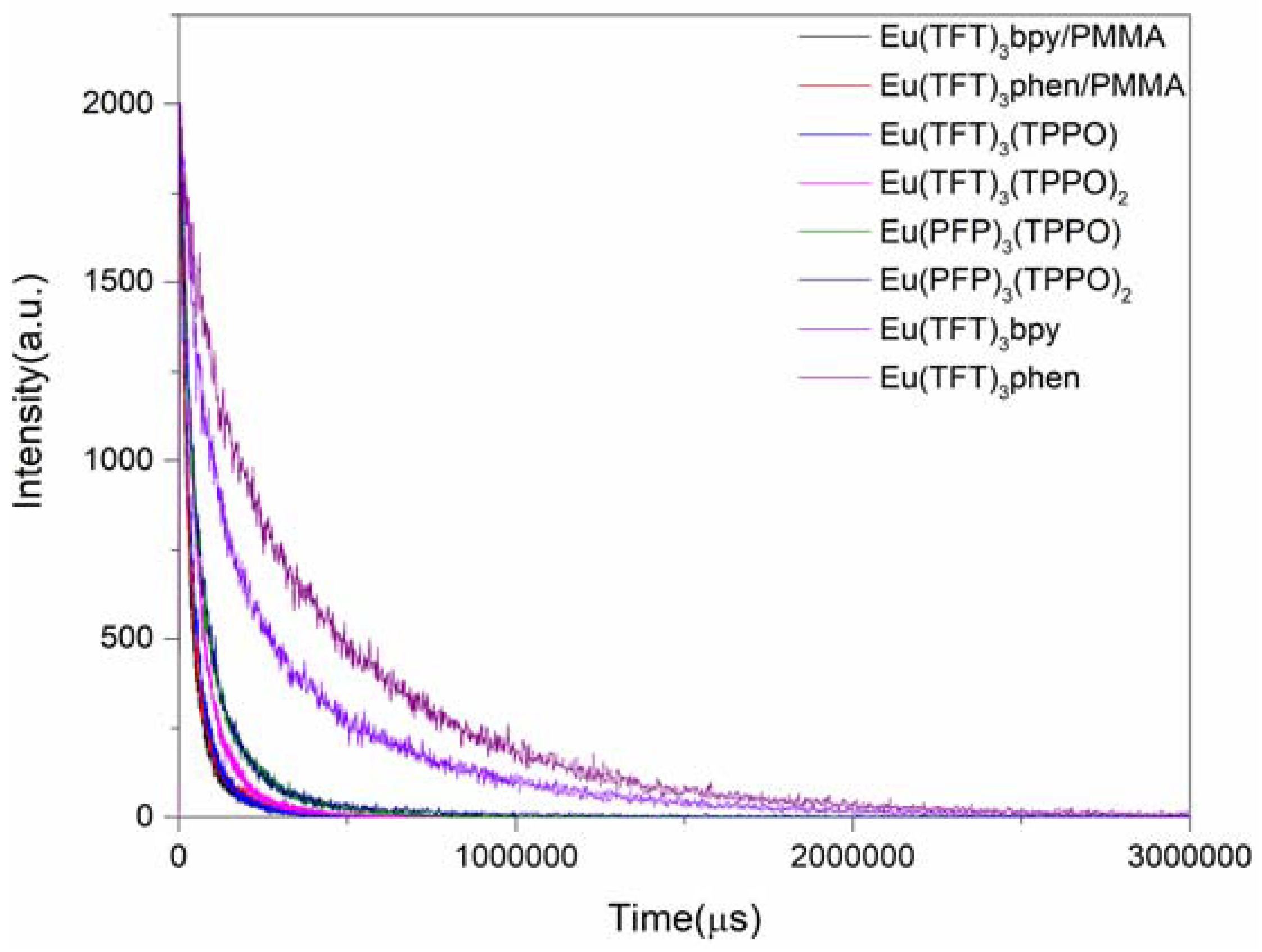
© 2018 by the authors. Licensee MDPI, Basel, Switzerland. This article is an open access article distributed under the terms and conditions of the Creative Commons Attribution (CC BY) license (http://creativecommons.org/licenses/by/4.0/).
Share and Cite
Zhao, W.; Shao, H.; Yu, G.; Hou, Y.; Wang, S. The Coordination and Luminescence of the Eu(III) Complexes with the Polymers (PMMA, PVP). Polymers 2018, 10, 508. https://doi.org/10.3390/polym10050508
Zhao W, Shao H, Yu G, Hou Y, Wang S. The Coordination and Luminescence of the Eu(III) Complexes with the Polymers (PMMA, PVP). Polymers. 2018; 10(5):508. https://doi.org/10.3390/polym10050508
Chicago/Turabian StyleZhao, Weican, Haifeng Shao, Guang Yu, Yanjun Hou, and Shuhong Wang. 2018. "The Coordination and Luminescence of the Eu(III) Complexes with the Polymers (PMMA, PVP)" Polymers 10, no. 5: 508. https://doi.org/10.3390/polym10050508




